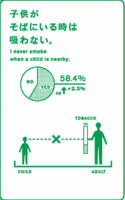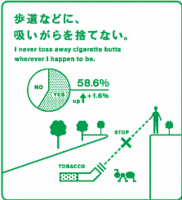Tuesday, August 30, 2005
Monday, August 29, 2005
GDP 2005

The yearly Good Design Presentation, which is part of the Good Design Award took place this weekend in Tokyo. On display were more than 2,000 products nominated for this year's G-Mark. Especially interesting were products from the area of information and communication design, and also some traditional Japanese designs which are currently being rediscovered by large manufacturers.
Friday, August 26, 2005
Mobaho

Mobaho is a satellite broadcasting service to portable receivers - sort of a portable TV. It is broadcasting throughout Japan. Service has startet last year, but only now the company has come up with a campaign similar to internet access providers such as TEPCO, offering several months for free with a new contract.
Thursday, August 25, 2005
Green tea 101

Young Japanese consumers seem to know green tea only in its canned or bottled variety, to be purchased from vending machines. The portal MSN, together with the online shop for health supplyments K Navi, is explaining the basics of green tea to these consumers - a great example of the recent trend of selling traditional Japan back to the Japanese.
Saturday, August 20, 2005
Summer adverts
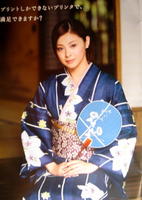

Epson has released two summer themed ads for its printer Colorio - a rare example of a non-Japanese company coming up with an advert that refers to the four seasons. Japanese companies use such references much more frequently - there is no escaping adverts featuring cherry blossoms in spring or autumn leaves in fall. My local supermarket has just put up signs with the word "autumn" - and it is still mid-August!
People in Japan are generally very proud of the four seasons - which is often surprising to someone from Europe or the US as four seasons are of course not unique to Japan. The difference is that everyday life in Japan reflects the seasons much more strongly, as there is an abundance of seasonal foods and activities. Furthermore, a rich variety of seasonal signifiers such as the above cherry blossoms were and are still used in traditional arts, for example Japanese-style painting and poetry. Of course consumers these days only recognize the most obvious ones, but they are recognized immediately and the associations they evoke are positive.
For some reason, however, foreign companies seem to prefer adverts without any seasonal content - maybe because the same ads are used in countries other than Japan as well. But even as ads targeted specifically to the Japanese market very rarely contain seasonal signifiers. I wonder whether this is done on purpose (to convey an international or foreign image, maybe) or companies are simply not sufficiently aware of the importance of these cultural codes and therefore they get lost in increasingly globalized advertising campaigns.
Thursday, August 18, 2005
Tuesday, August 16, 2005
Carlsberg

In an effort to increase its popularity, Carlsberg has published a supplement in the popular free paper Metro Min., which introduces restaurants and bars offering the beer.
Monday, August 15, 2005
Dove Real Beauty

Dove has launched the Campaign for Real Beauty in Japan with interactive billboards and a website where viewers can voice their consent or dissent on common beauty stereotypes such as freckles or grey hair.
Absolut Metropolis

The vodka brand Absolut is featuring underground culture from Tokyo in its new campaign Absolut Metropolis. According to the website, "the streets of Tokyo were scoured to find eye-catching individuals who exhibit their own vibrantly original style, fused from influences and ideas from all over the world." These were then asked by Absolute to create costumes for the brand.
Although the website is bilingual, it seems to be another attempt - like Lost in Translation or Gwen Stefani's Harajuku Girls - to sell Japanese contemporary culture as perceived by a non-Japanese to other non-Japanese. And while these individuals might appear interesting and hip to people outside Japan, they would probably scare off the average salaryman (or even university student) instead of convincing them to give Absolut vodka a try.
Saturday, August 13, 2005
2005 ADC

Some of the adverts and campaigns which have been nominated by the Tokyo Art Directors Club and were on display in the annual ADC Exhibition in July. While the revival of designs and images from traditional Japan is still going strong, the new trend in graphic design and advertising is definitely "green advertising".

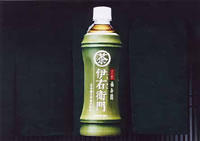

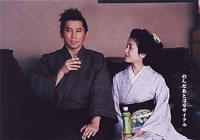
Friday, August 12, 2005
Mote-bra

"Mote-kei" (which can be translated as "popular with (the opposite sex)" has been a major trend in male fashion during the last few years, and now has crossed over to female fashion as well, as can be seen in the mote-bra.
This trend is not limited to underwear, has become evident in fashion and make-up as well. Interestingly, it is based on Japanese brands, not foreign designer wear. The aim is a style popular with men - not agressive, but also not overly cute.
Thursday, August 11, 2005
You've got one too?!
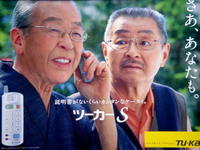
The smallest mobile carrier in Japan Tu-ka is using peer pressure to convince senior citizens to buy the Tu-ka S. Although the handset has been a hit product for the company since its release in 2004, I am not sure that it is really the elderly who are dropping into Tu-ka stores and grab the handsets - considering the fact that many senior citizens continue living in the countryside while their children have moved to Tokyo or another large city, most handsets are probably presents from these children so they can easily get in touch with their parents.
Wednesday, August 10, 2005
Freeters' consumption patterns
The business daily Nikkei has published a study of consumption patterns of freeter and regular workers. Freeter (often translated as freelance part-time workers) are generally defined as people between 15 and 34 who, after finishing education, do not enter a company as a regular employee but instead work as temporary staff or continue working in "student-type" part-time jobs. The number of freeter is estimated at about 4 million people, but some forecasts predict this number to rise to 10 million in 2014.
There is an ongoing debate whether freeter choose this lifestyle or it is forced on them as companies cut recruitment for new graduates and shift jobs to temporary staff. According to the above survey, the majority of freeter choose this lifestyle in order to have the time and resources to "pursue their dreams". However, freeter pay for their additional free time with considerably reduced income and career prospects. So how does this impact their lifestyle and consumption preferences?
Among the major findings of the survey are:
There is an ongoing debate whether freeter choose this lifestyle or it is forced on them as companies cut recruitment for new graduates and shift jobs to temporary staff. According to the above survey, the majority of freeter choose this lifestyle in order to have the time and resources to "pursue their dreams". However, freeter pay for their additional free time with considerably reduced income and career prospects. So how does this impact their lifestyle and consumption preferences?
Among the major findings of the survey are:
- Consumption by freeter is focused on their hobbies and dreams.
- Despite their lower income, freeter and regular employees spend similar amounts (in absolute numbers) on fashion, but purchase in very different locations.
- Monthly expenses for leisure are also surprisingly similar, but spent on different kinds of products.
- The activities of freeter are more focused on their immediate neighbourhood.
The results are interesting not only because they provide new and unexpected insights into the freeter lifestyle, but also because they shed light on a more general shift: the changes in consumption patterns resulting from the casualization of the Japanese labor force.
An increasing number of Japanese companies, both start-ups and large companies, have discovered this market and have developed products and services ranging from employment agencies to financial services targeted to freeters.
Tuesday, August 09, 2005
Summer chocolate


Morinaga has released Bake, a chocolate which does not melt. This makes it ideal for the Japanese summer, when consumers generally do not buy chocolate because of the heat (in the last week for example, temperature in Tokyo even at night has not dropped below 25 degrees Celsius). The TV commercials feature uber-idol Hamasaki Ayumi.
Wednesday, August 03, 2005
Aiful

The consumer finance company Aiful has been hugely successful with its usage of a chihuahua in its adverts from 2002 and sparked a boom of chihuahuas as pets. A short movie featuring scenes from the latest advert as well as a web-only short movie itself can be viewed on the company's website.
Tuesday, August 02, 2005
Mottainai


Illustrating the recent trend towards environmental awareness and sustainability, the trading house Itochu has announced to create a brand to support Nobel Peace Prize winner Wangari Maathai's campaign not to waste ressources. Wangari Maathi picked up the Japanese expression "mottai nai" (What a waste) during a stay in Japan, and this slogan will appear on a range of products from T-Shirts to tableware.

